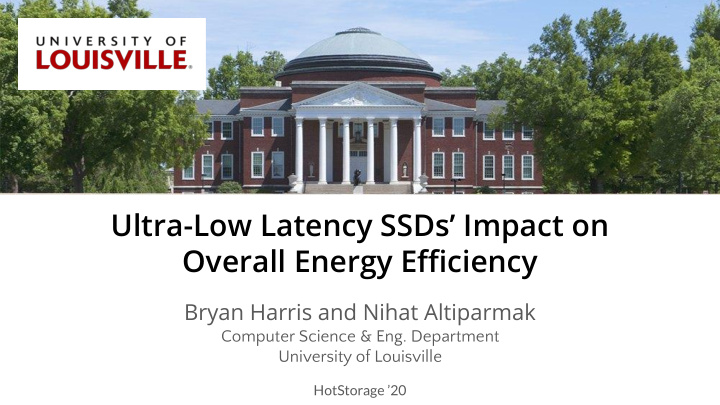



Ultra-Low Latency SSDs’ Impact on Overall Energy Efficiency Bryan Harris and Nihat Altiparmak Computer Science & Eng. Department University of Louisville HotStorage ’20
What is Ultra-Low Latency (ULL) data access? Performance Gap Device Latency (relative to DRAM) ∼ 10 ms 100,000× HDD ∼ 100 μs 1000× Traditional SSD ∼ 10 μs 100× Ultra-Low Latency SSD ∼ 100 ns 1× DRAM 2
What is Optane SSD ? Based on 3D Xpoint technology by Intel and Micron, using phase change memory (PCM) Ideal for applications that require low latency access Also available as byte addressable DIMM 3
Motivation Energy characterization ● Existing studies of Optane SSDs primarily focuses on performance ● Energy studies look at only individual device or CPU usage Impact on overall system software ● ULL disk IO puts increased pressure on system software ● How does this affect power consumption? 4
HotStorage ’20 Energy Characterization & Impact 5
Test devices Technology Interface Model Capacity Magnetic SATA 3.1 WD Black 7200 rpm 4 TB Flash SATA 3.1 Samsung 850 EVO 1 TB Flash PCIe 3 Samsung 960 EVO 500 GB 3D XPoint PCIe 3 Intel Optane 900P 280 GB 6
Experimental setup HOBO plug meter logs power, current, joules, etc., every second. Image from ONSET online catalog https://www.onsetcomp.com/products/data-loggers/ux120-018/ fio (“Flexible IO tester”) generates storage IO workloads 7
Storage IO workloads Larger data requests More simultaneous requests 8
HotStorage ’20 Observations 9
Idle vs. active power consumption Observation 1 At idle, Optane uses more power than Flash SSDs 10
Idle vs. active power consumption Observation 2 Active power increases with lower latency devices 11
Read vs. write power consumption Observation 3 Newer storage generations have greater differences in power consumption between reads and writes HDD (SATA) Flash (SATA) Flash (NVMe) Optane (NVMe) 12
Energy proportionality Consuming energy in proportion to the amount of work performed System power Power normalized to peak power observed Storage performance utilization IOPS normalized to peak IOPS for each device 13
Energy proportionality Observation 4 Newer advancements lead to better energy proportionality Reads Writes 14
Impact on system software Observation 5 As latency decreases, pressure on the system software increases, resulting in more overall energy consumption. Reads Writes 15
Impact on system software Effect on CPU Effect on Power 16
Overall energy efficiency metrics Performance per unit energy Bytes/second Bandwidth: = Bytes per joule watt (joule/second) IOPS Throughput: = IOs per joule watt (joule/second) 17
Impact on overall energy efficiency Observation 6 Energy efficiency as bytes per joule increases as request size increases. HDD (SATA) Flash (SATA) Flash (NVMe) Optane (NVMe) Bytes transferred per joule 18
Impact on overall energy efficiency Observation 7 Energy efficiency as IOs per joule is coupled to internal parallelism. Flash NVMe Optane SSD IOs per joule 19
Conclusion Optane SSD has the greatest energy proportionality since its power consumption scales better than previous storage generations based on its range of throughput. Although Optane’s peak power consumption is higher, it yields better energy efficiency as measured in bytes per joule and IOs per joule. 20
Discussion and future research Rethink system software for energy efficiency: Polling vs. interrupts? ● New IO interfaces: io_uring , SPDK , etc.? ● Simpler mechanisms for blk-mq and NVMe ? ● IO scheduling? ● Merging, prefetching, buffering, log structuring? ● 21
Discussion and future research Investigate R/W asymmetry : Why do writes use more CPU but fewer interrupts? ● Do existing design choices get in the way of 3D XPoint? ● Strategies for hybrid drives for energy efficiency ● 22
Discussion and future research Energy as a whole : Do performance optimizations lose sight of energy efficiency? ● Compared to CPU and memory, is the impact of the storage subsystem ● underestimated? 23
HotStorage ’20 Thank you! Questions? Please contact us: Bryan Harris bryan.harris.1@louisville.edu Nihat Altiparmak nihat.altiparmak@louisville.edu 24
References [1] Luiz André Barroso and Urs Hölzle. The case for energy-proportional computing. Computer, 40(12):33–37, 2007. https://doi.org/10.1109/MC.2007.443. [2] Kan Wu, Andrea Arpaci-Dusseau, and Remzi Arpaci-Dusseau. Towards an unwritten contract of Intel Optane SSD. In 11th USENIX Workshop on Hot Topics in Storage and File Systems (HotStorage ’19) , Renton, WA, July 2019. USENIX Association. https://www.usenix.org/conference/hotstorage19/presentation/wu-kan [3] Sehgal, Priya, Vasily Tarasov, and Erez Zadok. "Evaluating Performance and Energy in File System Server Workloads." FAST 2010. 25
Recommend
More recommend